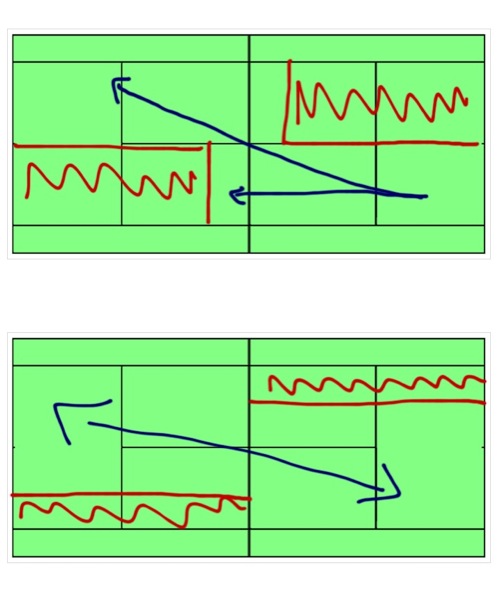
Our first request for a drill comes from Paul N. from Iowa. Paul runs a small junior academy and, with winter coming, he wanted to know if with limited time and court space there would be a practical way to have 6 or more players on court without it becoming a zoo or resulting in too much loafing around. I said, "buddy, you came to the right place." You see, in Romania we only had 3-4 indoor, wood courts/city and those would have to be shared with: volleyball, team handball, basketball, indoor soccer, gymnastics, martial arts, etc. So whenever we had access to a tennis court we were forced to not just double up, but quintuple up (and whatever the proper word may be for 6, 7, 8 or more). What can I say, in US we watched "Rocky"; in Eastern Europe we lived it. So here are the drills:
Figure 1: one pair of players practices short court down-the line. Since they stay just inside the baseline, they have better ball control so they shouldn't need as much room. Therefore, the doubles alley is all they need. A pair of players hit volley-volley (tap-tap). Again, they also do not need much room. The other pair of players hit from baseline and thy need more room to hit. This is usually a good way to warm up. Other players may be jumping rope, running or doing some other physical exercise. Players would cycle in, work their way through every position and then transition to/fitness routine.
Figure 2: This is for 6 players on court. Two players (on their own "X") hit cross court. On the other side, one player lines up right behind each other. These players hit the ball cross-court also and then move outwards toward the sidelines allowing the other player to hit the next shot. Usually, there were specific markers that the player would have to touch or run around. This way, players practiced hitting as well as movement. In many of these drills, more emphasis was put on movement than actual hitting. Same as above, some players could have been doing fitness in the corners waiting their turn.

Figure 3: In this drill, all players are at the net and hitting volley-volley. One player was usually by himself hitting volley against two players. This drill is fairly easy to figure out.
Figure 4: This is a variation of the drill in Figure 2 in that there are EIGHT (8) or 6 players on court hitting either cross-courts or down the line. Two players can line up right behind the other and hit either cross-courts or down the lines against another pair. A player wold hit the ball and then rotate wide and around making sure that she leaves plenty of room for his partner. The other half of the court would do the same. Again, with players doing fitness in the corners, you could easily have 12 players getting a good workout. This is a pretty challenging drill because movement and ball control are key. The players cannot just "hit the ball to get rid of it"; they have to hit the ball cleanly and with a lot of control.

Figure 5: In this drill, all 6 players are at the net hitting volleys. This is more of a "fun" game although it becomes QUITE CHALLENGING when two balls are added into the mix. It's a bit difficult to demonstrate on paper but the basic concept is that one of the player (in the alley) feeds the ball to the player in front of him, that player volleys it back diagonally to the "T" player; that player volley it in front of him to the other "T" player; that player volleys it diagonally to the alley player; that player volleys is in front of him to the other alley player that player then volleys it diagonally to the "T" player; and so on. A slight variation is where the "T" players do volley-volleys with the two alley players on the opposite side (wide "V" pattern).
Figure 6: This is a variation of the Figure 3 drill but, in this case, only two players are at the net ("T" position on both sides). The other 4 players (2 per set) are at the baseline. In this drill, one of the player hits both against a volley and a ground-stroke. This way, he gets to see both a topspin and a skidding volley (and boy did those balls skid on the wood surface).
In these drills, footwork and ball control are preeminent. I can tell you that sloppy work was more than frowned upon. You were expected to take pride in your work and show "teamwork" because this was EVERYONE'S practice not just yours. But we can see that with some imagination and some hard work, there is a workable way to make a decent practice happen for 6 or more players on court. In addition, these drills will demonstrate the benefits of combining tennis and fitness at the same time.
Please feel free to send questions, drill suggestions or requests to catenniseditor@gmail.com.
 Saturday, October 22, 2011 at 12:44PM
Saturday, October 22, 2011 at 12:44PM  CAtennis
CAtennis 





